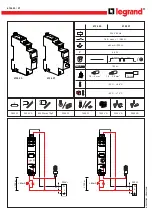
Rev. 07
5/138
1.
RECEPTION, HANDLING & INSTALLATION
1.1.
Unpacking
Relays must only be handled by qualified personnel and special care must be taken to protect all of their
parts from any damage while they are being unpacked and installed. The use of good illumination is
recommended to facilitate the relay visual inspection.
The facility must be clean and dry, and relays should not be stored in places that are exposed to dust
or humidity. Special care must be taken if construction work is taking place
.
1.2.
Reception of relays
It is necessary to inspect the relay at the time it is delivered to ensure that the relays have not been
damaged during transport.
If any defect is found, the transport company and FANOX should be informed immediately.
If the relays are not for immediate use, they should be returned to their original packaging.
1.3.
Handling electronic relay
Relays contain an electronic component that is sensitive to electrostatic discharges.
Just by moving, a person can build up an electrostatic potential of several thousand volts. Discharging
this energy into electronic components can cause serious damage to electronic circuits. It is possible
that this damage may not be detected straight away, but the electronic circuit reliability and life will be
reduced. This electronic component in the relay is well protected by the metal housing, which should
not be removed as the relay cannot be adjusted internally.
If it is necessary to disassemble the electronic component, this must be carried out with care and contact
with electronic components, printed circuits and connections must be avoided to prevent an electrostatic
discharge that could damage one of the components. If the electronic components are stored outside
the metal housing, they must be placed in an antistatic conductive bag.
If it is necessary to open a module, care must be taken to preserve the relay reliability and the duration
of the life cycle as designed by the manufacturer by taking the following actions:
•
Touch the housing to ensure that you have the same potential
•
Avoid touching the electronic components and handle the module by its edges.
•
Remember that everyone who handles the module must have the same potential.
•
Use a conductive bag to transport the module.
For more information about how to handle electronic circuits, consult official documents such as the IEC
147-OF.
Summary of Contents for SIA-B Series
Page 8: ...www fanox com Rev 07 8 138 Cut out pattern 2 3 Striker dimensions 2 3 1 PRT 15...
Page 9: ...www fanox com Rev 07 9 138 2 3 2 PRT A 44 5 B 49 5 C 56 5 D 64 5 E 42 5...
Page 10: ...www fanox com Rev 07 10 138 2 4 Connection diagram NOTE STRIKER 6 24 Vdc 0 135 W s...
Page 28: ...www fanox com Rev 07 28 138...
Page 35: ...www fanox com Rev 07 35 138...
Page 36: ...www fanox com Rev 07 36 138...
Page 37: ...www fanox com Rev 07 37 138...
Page 38: ...www fanox com Rev 07 38 138...
Page 40: ...www fanox com Rev 07 40 138...
Page 41: ...www fanox com Rev 07 41 138...
Page 42: ...www fanox com Rev 07 42 138...
Page 76: ...www fanox com Rev 07 76 138 6 3 Standards...
Page 77: ...www fanox com Rev 07 77 138...
Page 137: ...www fanox com Rev 07 137 138 NOTES...
Page 138: ...www fanox com Rev 07 138 138...






































